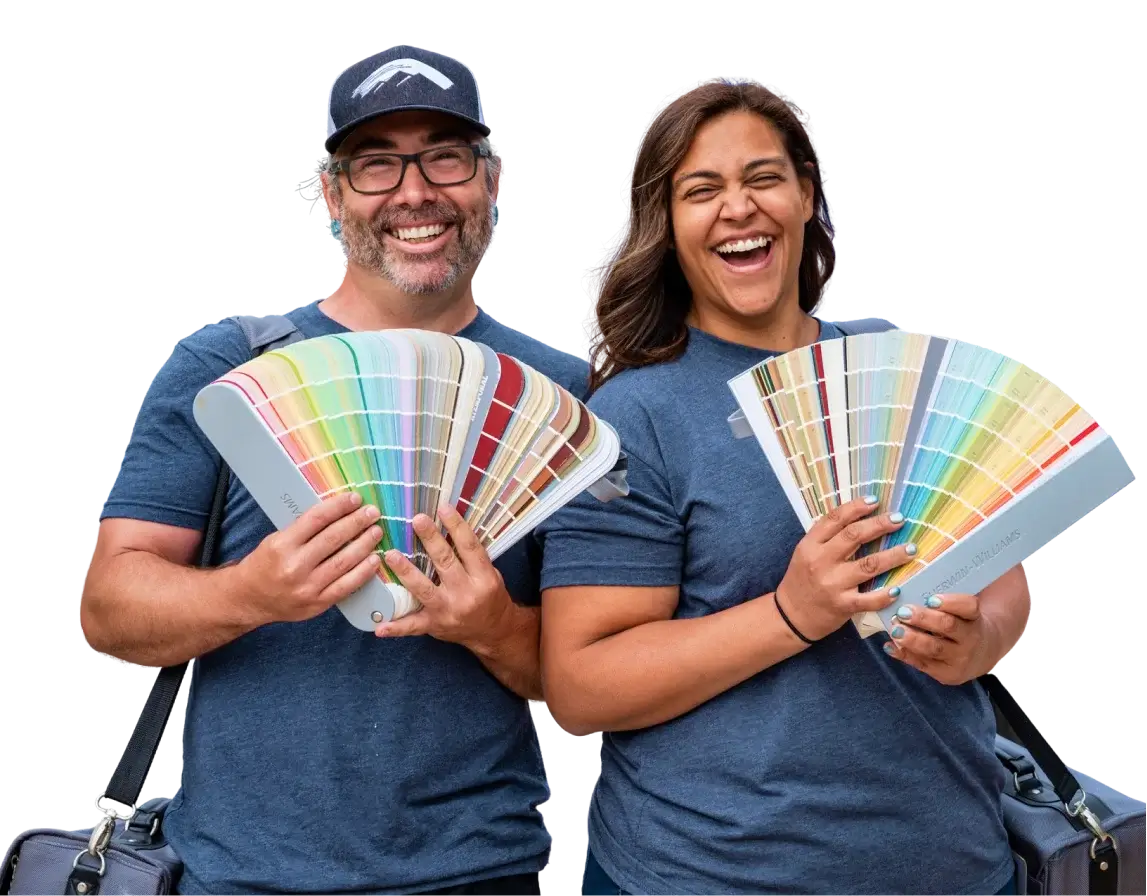Hey there! If you’re interested in the psychology of paint colors in interior design, you’re not alone. The colors we envelop ourselves in daily, especially where we hit the hay, can profoundly impact our mood and overall well-being. Let’s explore the colorful world of interior residential painting choices and why they matter more than you might think.
Key Takeaways:
- Color Psychology Enhances Well-being: Calming hues like blues and greens reduce stress, promoting relaxation and improved bedroom sleep.
- Bright Colors Combat Seasonal Affective: Incorporating vibrant colors can elevate mood and counteract the effects of Seasonal Affective Disorder during darker months.
- Effective Stress and Anger Management: Strategic color choices in your home can significantly aid in managing stress and reducing feelings of aggression.
- Energy Regulation Through Color: Bright colors boost energy and mood, while darker tones can calm and reduce overstimulation in living spaces.
- Improved Relationships Via Color: Colors that induce positive emotions enhance social interactions and communication, deepening bonds and encouraging new connections.
The Serenity Spectrum: Why Bedroom Colors Matter
It’s no secret that the right bedroom ambiance, shaped by interior residential painting, can transform your space from just another room into a tranquil retreat. But with a kaleidoscope of colors at your fingertips, making the best choice can seem daunting. Homeowners understand the stakes are high—the colors you pick through interior residential painting can either enhance your nightly recharge or keep you tossing and turning.
Benefits of Color Psychology in Interior Design
Embracing the psychology of paint colors in interior design isn’t just about aesthetics; it’s about enhancing your well-being through strategic color choices.
- Stress and Anger Management: Surrounding yourself with calming colors can help you cope better with stress and mitigate feelings of aggression. A pleasant environment that evokes happiness, energy, and motivation reduces susceptibility to stressors and negative emotions.
- Mood Elevation: Incorporating bright colors can combat symptoms of Seasonal Affective Disorder (SAD) by introducing warmth and comfort into your home during the darker winter months. Studies suggest that these colors can boost dopamine levels, enhancing your mood.
- Improved Sleep: Colors influence your circadian rhythm, particularly through colored light exposure. While blue and green light can disrupt sleep, red or amber hues benefit melatonin production, enhancing sleep quality.
- Energy Regulation: Vibrant, cheerful colors can rejuvenate your mental state and boost energy—ideal for those with depression or lethargy. On the other hand, dark colors can help calm excessive energy.
- Enhanced Communication and Relationships: Colors that foster positive emotions can make individuals more open to social interactions, improving communication and deepening relationships. Conversely, dark or muted tones might reduce communicativeness, impacting social engagement.
Psychology of Paint Colors in Interior Design: Finding the Right Hue for You
Red
Red in interior residential painting is associated with love, passion, and sometimes anger. It stimulates action and confidence and raises heart rate and blood pressure. Due to its vibrant and energetic nature, red is typically too stimulating for bedrooms and relaxing spaces. Instead, it might be better suited for dynamic areas like dining or living rooms where interaction and activity are encouraged through interior residential painting.
Orange
Orange in interior residential painting brings excitement and enthusiasm and is known to boost energy and stimulate creativity. While it might be too lively for a bedroom, using orange sparingly can inject fun and energy without overwhelming it. It’s particularly effective in children’s or teenagers’ bedrooms as accent walls or decor, complementing a youthful and vibrant atmosphere.
Yellow
Through interior residential painting, yellow resonates with joy and communication but is also quite stimulating. Lighter shades of yellow benefit bedrooms, mainly if you aim to create a cheerful environment for waking up. However, brighter yellows might be overwhelming, so it’s advisable to opt for softer, more muted yellow tones to maintain a calming atmosphere.
Pink
Pink is linked with tenderness and love in interior residential painting and is known for its calming effects. It is an excellent choice for bedrooms, offering a soothing presence that can help diminish aggression and enhance the feeling of calm. Pink shades are particularly effective in creating a nurturing and relaxing bedroom environment.
Green
Green, a staple in interior residential painting, symbolizes balance and renewal, encouraging independence while soothing sadness. It is one of the best color choices for bedrooms, mirroring the calming effects of nature and promoting a stimulating atmosphere that supports both mental and emotional well-being.
Blue
Blue, often seen as the epitome of calmness and serenity in interior residential painting, is known for its ability to lower stress, heart rate, and blood pressure, making it ideal for a sleep environment. It is highly recommended for bedrooms, where it can transform the space into a peaceful retreat conducive to deep and restful sleep.
Purple
Purple, particularly in lighter hues like lavender, promotes relaxation and creativity in interior residential painting. While darker purples might stimulate the mind too much for a restful night, lighter shades can create a luxurious and calm atmosphere, making them suitable for bedroom walls.
Brown
Brown offers a grounding effect in interior residential painting, increasing feelings of stability and resilience. It’s earthy and comforting, making it a solid choice for bedrooms when combined with softer textures and complementary colors to enhance the room’s coziness and warmth.
Gray
Gray delivers a modern and calming effect in interior residential painting, though it can dampen moods in too-dark shades. It works exceptionally well in bedrooms as a neutral, providing a sophisticated backdrop that pairs seamlessly with a wide range of accent colors to craft a tranquil and stylish space.
White
White, known for purity and simplicity, helps expand perceived space while sometimes overstimulating if it is too bright. It works best as a base color in bedrooms, complemented by colorful accents to create a balanced and inviting environment.
Black
Black, used sparingly, brings sophistication and a sense of luxury. It is ideal as an accent rather than the primary color in bedrooms, adding depth and focus to the design without making the space feel smaller or overly enclosed.
Beyond Brushstrokes: Foothills Painting’s Holistic Approach
Foothills Painting creates a mood through interior residential painting. Their approach is all about ensuring your bedroom’s new color fits seamlessly into your lifestyle, promoting a beautiful aesthetic and a harmonious sleep environment. They understand that a minimal disruption policy is crucial for busy homeowners, ensuring the transformation of your bedroom happens smoothly and cleanly through interior residential painting.
Your Bedroom, Your Sanctuary
Choosing the perfect bedroom color with Foothills Painting through interior residential painting means you’re not just redecorating; you’re redefining your rest space! It’s about crafting an environment that aligns with your style and psychological needs, ensuring every night is good.
Ready to transform your bedroom into a bastion of calm? Foothills Painting is just a phone call away. Dial in your dream bedroom today and wake up to a better tomorrow. Give them a ring at 970-427-2866, and let the color magic begin! A FREE estimate is just a phone call away for those in Fort Collins, Erie, Arvada, CO, and the surrounding areas.
So, grab your color swatches, flick through those decor mags, and get your sleeping space set for serenity with top-notch guidance from Foothills Painting!







